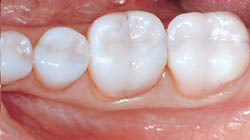- Dentistry Mosonmagyaróvár
With regular and proper oral care, we can do a lot for the integrity of our teeth, but even with the most perfect oral hygiene, a tooth can start to decay. If the carious area is not yet too large, it only penetrates to the middle layer of the tooth, the dentin, and is not associated with inflammation of the gums, the damage can be repaired by simply filling the tooth.

Previously, dental fillings were made of metallic amalgam, but nowadays the use of aesthetic, tooth-colored, so-called composite fillings has become widespread. The composite material, which consists of a special synthetic resin and ceramic nanoparticles, has to be applied in layers, to “build up” the missing parts of the tooth with it. The liquid composite resin polymerizes under UV action and solidifies immediately. It binds extremely strongly to the tooth, so it is not necessary to form a too deep cavity when used, ie most of the intact tooth tissue can be preserved.

The whole process can be done in a short time in one meeting in the office.
Depending on your oral care habits, genetics, and diet, the rate at which your teeth decay and how often you need to have their caries restored with dental fillings varies greatly, but it is very rare for someone to have at least one or two caries in their adulthood. The caries process is often asymptomatic and can only be noticed by a specialist at first, so regular dental check-ups at least once a year are extremely important!
Drilling is done with modern water-cooled equipment and local anesthesia, so there is no pain. After treatment, the tooth and its surroundings may be temporarily more sensitive, but this will go away within a few days.
There are different types and shades of aesthetic composite fillings, which can be mixed together if necessary, so by choosing the right material (s), the filling will be the same as the original tooth in both color and transparency. Since the boundary line between the tooth and the filling is practically invisible to the naked eye, the composite filling material can also be used to treat caries in the front teeth.
The composite fillings used today are very strongly bonded to the tooth material and are very resistant, but it is important to know that none of the dental fillings last forever! If the filling ages, cracks, breaks, or decay begins, replacement is required. An aesthetic composite filling can perform its function properly for an average of 5-10 years.

Fill out the form, click the login button, and we will contact you soon.
Dr. Bekő Gabriella
Implanmed © 2022. All rights reserved!